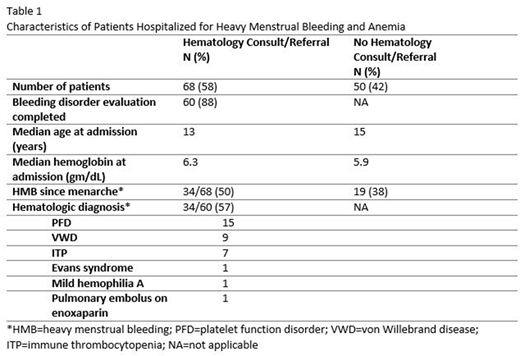Abstract
Background: Heavy menstrual bleeding (HMB) in adolescents can be severe and life-threatening. Up to 30% of young women who are hospitalized with anemia due to HMB have a bleeding disorder. Guidelines from the American College of Obstetrics and Gynecology (ACOG) and the National Heart, Lung, and Blood Institute (NHLBI) recommend evaluation for bleeding disorders in such patients. ACOG recommendations include testing for von Willebrand disease (VWD) and specify that consultation with a hematologist may help in interpreting results. NHLBI recommends testing for vWD be done in conjunction with a hematologist. As von Willebrand factor is an acute phase reactant, testing when patients are severely anemic and bleeding may not provide accurate results. ACOG guidelines do not include testing for platelet function disorders (PFD), though PFD may be as prevalent as VWD in females with HMB. Early and accurate diagnosis of bleeding disorders is important for health and quality of life, yet limited data exists on the diagnostic evaluation for bleeding disorders in adolescent females hospitalized for HMB.
Objectives: To evaluate the diagnostic evaluation of bleeding disorders in adolescent females hospitalized for HMB.
Methods: A retrospective, single center chart review of female patients aged 9-21 years hospitalized for HMB and anemia at a tertiary care children's hospital from January 1, 2000 until December 31, 2017 was done. HMB was defined as menses ≥7 days in length, use of 8 or more pads or tampons per day during menses, pictorial bleeding assessment chart (PBAC) score greater than 100, or symptomatic anemia. Patients were identified from our Hemophilia Treatment Center (HTC) registry, review of patients seen at a comprehensive clinic staffed by pediatric hematologists and gynecologists for adolescent females with HMB and bleeding disorders, and by an Electronic Medical Record (EMR) query of admission and discharge diagnoses of HMB and anemia. Data obtained included clinical features, diagnostic evaluation, and laboratory results.
Results: 118 patients hospitalized for HMB and anemia were included. Inpatient Hematology consult or outpatient referral occurred in 68 (58%) of the patients; 60/68 (88%) had a bleeding disorder evaluation completed. 34 patients had a hematologic disorder. PFD was the most common (15/34; 44%) followed by VWD (9/34; 26%). 42% (50/118) of the patients did not have a Hematology consult or outpatient referral (Table 1). While hospitalized for HMB and anemia, 29 of the 50 patients had testing for vWD performed and only 4/29 (14%) had testing repeated as an outpatient once hemoglobin normalized. No patients tested for VWD while inpatient had results consistent with the diagnosis. Platelet function testing was performed in 10/50 patients using the platelet function analyzer (PFA-100) in 8 patients and platelet aggregometry in 2 patients.
Conclusions: Despite national guidelines and the presence of known risk factors such as HMB since menarche and HMB causing severe anemia, the hematology service was not involved in the diagnostic process for a significant number of adolescent females. In these patients, testing often occurred while patients were hospitalized and was not repeated. Testing for platelet function disorders occurred infrequently and mainly consisted of the PFA-100 which lacks sensitivity and specificity. When patients were evaluated by Hematology and tested for bleeding disorders, a large proportion had a bleeding disorder, of which PFD were most common. This study demonstrates the need for standardization of the evaluation of adolescent females hospitalized for HMB. Guidelines should be updated to include testing for PFD. Hematologists should be involved when females are hospitalized for HMB and anemia.
Carpenter:Genentech Incorporated: Membership on an entity's Board of Directors or advisory committees; Nationwide Children's Hospital: Speakers Bureau; Bayer: Honoraria; Kedrion Pharmaceuticals: Membership on an entity's Board of Directors or advisory committees; Novo Nordisk Pharmaceuticals, Inc: Consultancy; HEMA Biologics: Consultancy; American Academy of Pediatrics: Membership on an entity's Board of Directors or advisory committees, Speakers Bureau; Novo Nordisk: Consultancy; National Hemophilia Foundation (Impact Education): Speakers Bureau; Kane County State's Attorney: Consultancy; CSL Behring: Speakers Bureau; 4th Judicial District Attorney's Office- Colorado: Consultancy; Kedrion Biopharmaceuticals: Consultancy.
Author notes
Asterisk with author names denotes non-ASH members.


